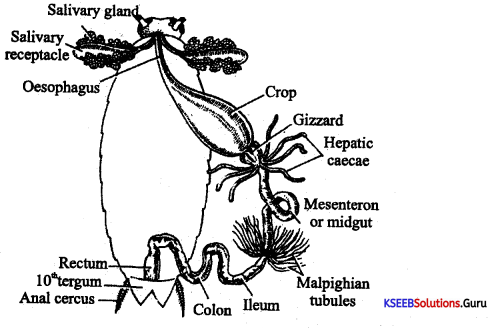Students can Download 1st PUC Biology Model Question Paper 5 with Answers, Karnataka 1st PUC Biology Model Question Papers with Answers helps you to revise the complete Karnataka State Board Syllabus and score more marks in your examinations.
Karnataka 1st PUC Biology Model Question Paper 5 with Answers
Time: 3.15 Hours
Max Marks: 70
General Instructions:
- The question paper consists of four parts A, B, C and D.
- All the parts are compulsory.
- Draw diagrams wherever necessary. Unlabelled diagrams or illustration do not attract any marks.
Part – A
Answer the following questions in one word / one sentence each: ( 10 × 1 = 10 )
Question 1.
What is a botanical garden?
Answer:
These are collections of living plants maintained for reference, i.e., they are meant for identification and classification. Both local and exotic plants are grown.
Question 2.
What are heterocysts?
Answer:
Heterocysts are enlarged thick-walled cells present in cyanobacteria which help in nitrogen fixation and asexual reproduction.
Question 3.
Name the chemical present in the cell wall of a diatom.
Answer:
Silica and Cellulose.
Question 4.
What is a phylloclade?
Answer:
A stem modification to carry out photosynthesis and often without leaves.
![]()
Question 5.
What is a ligament?
Answer:
Fibers connect bone to bone.
Question 6.
What is bolting?
Answer:
Internode elongation and early flowering induced by gibberellins are called bolting.
Question 7.
Define Imbibition?
Answer:
Imbibition is a special kind of diffusion that involves the movement of water molecules along a diffusion gradient from a region of higher concentration to a suitable solid matrix (adsorption).
Question 8.
Name any two hormones produced in the Gastro-Intestinal tract.
Answer:
Gastrin and Secretin.
Question 9.
Name the chemical present in the secondary cell wall?
Answer:
Lignin.
![]()
Question 10.
What is adelphy?
Answer:
When stamens are partially or completely fused among themselves, it is called adelphy.
PART-B
Answer any FIVE of the following questions in 3-5 sentences each. (5 × 2 = 10)
Question 11.
List the main differences between mitosis and meiosis. .
Answer:
(i) Mitosis consists of single nuclear divisions.
Meiosis consists of two nuclear divisions.
(ii) In Mitosis, crossing over is absent.
In Meiosis, crossing over is present.
Question 12.
What is a transamination reaction? What is its significance?
Answer:
Transamination:
In this process, the amino group is transferred from one amino acid to the keto group of a keto-acid.
Glutamic acid is the main amino acid that transfers its NH2 group to form seventeen other amino acids.
The reaction is catalyzed by the enzyme transaminase.

It results in the formation of amino acids.
Question 13.
What are nephridia? Mention the types of nephridia in earthworms?
Answer:
It is the excretory organ of the members belonging to Annelida.
There are 3 types of nephridia:
(a) Septal nephridia – Being is the segment.
(b) Integumentary nephridia – Inner side of the body wall in all segment expects.
(c) Pharyngeal nephridia – 4th, 5th, and 6th segments.
Question 14.
What are Ammonotelic animals? Give an example?
Answer:
Animals that excrete ammonia as nitrogenous waste products are called ammonotelic animals.
e.g: Aquatic invertebrates and bony fish, larvae of frog (Tadpole).
![]()
Question 15.
With reference to growth, define the following terms:
(a) Differentiation.
(b) Dedifferentiation.
Answer:
Differentiation: It is the conversion (maturation) of meristematic cells, to regain the power to divide under certain conditions.
Dedifferentiation: Permanent cells like parenchyma can revert back to meristematic activities (cell division) to form secondary meristem. This conversion is called Dedifferentiation.
Question 16.
What are the characteristic features of Euglenoids?
Answer:
Members of this phylum are freshwater, flagellate, and motile forms.
A single flagellum is found at the anterior end.
The flagellum develops from basal granule and an eyespot or stigma is present near to it. The cells have an elastic pellicle that gives a definite shape to the cell.
Euglena is photosynthetic when optimum light is available and is non-photosynthetic in the absence of light and engulfs the food materials. Hence it is described as mixotrophic. Contractile vacuoles help in osmoregulation.
Reserve food occurs in the form of paramylum starch.
Asexual reproduction is by longitudinal binary fission.
Question 17.
How are viroids different from viruses?
Answer:
Viroids: These are the small infectious self-replicating RNAparticles lacking protein coats.
Viruses: Viruses are regarded as ‘living entities’ since they exhibit living character when they occur within a host cell as intracellular parasites.
A typical virus consists of a central core of nucleic acid either DNA or RNA, surrounded by a protective protein coat called a capsid.
Question 18.
Name the cells of cartilage and bone.
Answer:
Chondrocytes and osteocytes.
PART-C
Answer any FIVE of the following questions in 40-80 words each: (5 × 3 = 15)
Question 19.
What is aestivation? Mention any two types of aestivation with one example of each.
Answer:
The mode of arrangement of sepals, petals, or even tepals in a flower bud is called aestivation.
The different kinds of aestivation are as follows:
1. Valvate aestivation: When sepals, petals, or tepals are not overlapping.
2. Imbricate aestivation: When out of the total number of sepals, petals, or tepals, one is completely out, one is completely in and the rest are in and out.
3. Descending imbricate aestivation: When the standard petals are large and overlap the two wing petals, which in turn overlap the keel petals. It is technically known as vexillary aestivation.
Note: It is characteristic of the members of the subfamily Papilionoideae (Papilionaceae).
e.g: Pea, Bean, Indigofera, Tephrosia, etc.
4. Ascending imbricate aestivation: When the small standard petal is completely ¡n and is overlapped by the lateral wing petals which in turn are overlapped, by the keel petals.
Note: It is characteristic of the sub-family Caesalpinioideae (Caesalpinae).
e.g: Caesalpinia pulcherhima, Delonix regia, etc.
5. Quincuncial aestivation: When out of the total number of sepals or petals, two are completely out, two are completely in and the rest are in and out.
6. Contorted or twisted aestivation: When all sepals or petals are both in and out.
![]()
Question 20.
Explain the digestion of Carbohydrates in the Human Small Intestine.
Answer:
a. Digestion in the mouth: The salivary amylase or ptyalin converts starch and glycogen into maltose units.

Intestinal juice: It consists of three types of carbohydrates.
Maltase: Maltase catalyzes the hydrolysis of maltose (disaccharide) into glucose units (monosaccharides).
![]()
Intestinal juice: It consists of three types of carbohydrates.
Maltase: Maltase catalyzes the hydrolysis of maltose (disaccharide) into glucose units (monosaccharides).
![]()
Sucrase: Sucrase catalyzes the splitting of súcrose (disaccharide) into glucose, and fructose units (monosaccharides).
![]()
Lactase: Lactase acts on milk sugar lactose (disaccharide), and splits lactose into galactose, and glucose units (monosaccharides).
![]()
Question 21.
Write the schematic representation of a Nitrogen cycle.
Answer:
Nitrogen Cycle:
- Nitrogen is a limiting nutrient for both natural, and agricultural ecosystems.
- It exists as two nitrogen atoms held together by strong triple covalent bonds (N = N).
The nitrogen cycle involves the following steps:
- Nitrogen fixation
- Ammonification
- Nitrification and
- Denitrification.
1. Nitrogen Fixation:
- The process of conversion of nitrogen into ammonia and/or other nitrogen compounds is known as nitrogen fixation.
- In nature, lighting and ultraviolet radiation provide energy, to convert nitrogen into nitrogen compounds like N2O, NO, and NO2.
- The atmosphere also gets some amount of nitrogen oxides from forest fires, automobile exhausts, industrial combustion, and power generating stations.
2. Ammonification:
- The process by which organic nitrogenous compounds arc decomposed to produce ammonia is known as ammonification.
- Some ammonia volatilizes and re-enters the atmosphere.
- Most of the ammonia is converted into nitrites and nitrates.
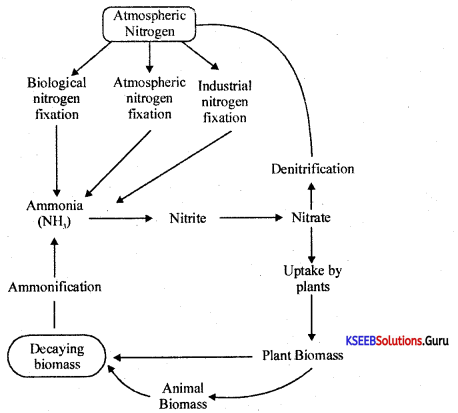
3. Nitrification:
Nitrification is the process of converting ammonia first into nitrite, and then into nitrate.
2NH3 + 3O2 → 2NO2 + 2H+ + 2H2O
2NO2 + O2 → 2NO3
- These processes are carried out by soil bacteria that are chemoautotrophs.
- Ammonia is oxidized into nitrite by Nitrosomonas and Nitrococcus.
- Nitrite ¡s oxidized to nitrate by Nitrobacter,
- The nitrates are absorbed by the plants. and reduced to nitrites.
- The nitrites are transported to the leaves and reduced to ammonia, which forms the amino group of amino acids.
4. Denitnfication:
- It is the process of conversion or reduction of nitrates into free nitrogen.
- It is carried out by bacteria like Pseudomonas and Thiobacillus.
![]()
Question 22.
What is meristem? Write any two kinds of meristems.
Answer:
Meristems are classified on the basis of their:
(A) Position.
(B) Function and
(C) Origin and development.
(A) Based on position, there are mainly three types:
(a) Apical Meristems: They are found at the tip of the stem and root. The activity of this, meristem leads to an increase in length.
(b) Intercalary Meristems: These are found between permanent tissues, at the base of the internode and leaf. The activity of this meristem leads to an increase in the length of the internode.
(c) Lateral Menstems: These are meristem is situated parallel to the sides of the organs and permanent tissues. Their activity leads to secondary growth.
(B) Based on function, there are three types:
(a) Protoderm: Gives rise to the epidermis.
(b) Procambium: Gives rise to primary vascular tissues (xylem, phloem, and intrafascicular cambium).
(c) Ground meristem: Gives rise to the cortex, hypodermis, pith, and medullary rays.
(C) Based on Origin, there are three types:
(a) Primordial meristems: Small groups of young embryonic cells existing in early stages of development. They give rise to Primary meristem. They are present in the stem tip and root tip.
(b) Primary meristems: They are directly derived from the Promeristems and divide rapidly. They are responsible for primary growth.
(c) Secondary meristems: These arise secondarily from permanent tissues by a process of dedifferentiation. Hence they appear much later in the life of a plant. They result in the later growth of plants.
Question 23.
List the living and nonliving characters of viruses.
Answer:
The living characters are:
- They occur as obligate parasites and can grow and reproduce within a host cell.
- They occur indefinite forms and contain genetic material -either DNA or RNA.
- They are pathogenic and cause infectious diseases like other pathogenic organisms.
- They show sensitiveness to heat and cold, like other organisms.
The non-living characters are:
- They exhibit a cellular nature i.e., they lack protoplasmic bodies such as cell wall, cell membrane, cytoplasm, nucleus, mitochondria, Golgi bodiès, E.R, ribosomes, etc.
- They cannot grow and multiply when they are outside the host cell., They look inert.
- They do not show cellular metabolism like respiration.
- They can be isolated, crystallized, and stored like any other chemicals.
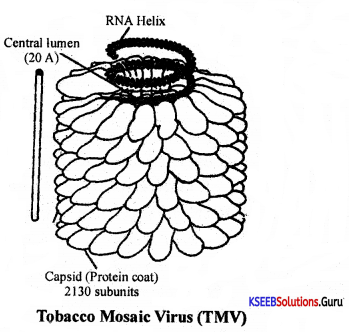
Note:
- Shape: Viruses may be rod-shaped, spherical, tadpole, tetrahedral, octahedral, or icosahedral.
- Size: Viruses are measured ¡n nanometer units. The size of viruses arises from 30 to 350 nm. eg: Pox vines – 300 nm, foot and mouth virus – 30 nm, psittacines -300 mn.
- Structure: A typical virus consists of a central core of nucleic acid either DNA or RNA, surrounded by a protective protein coat called a capsid. The nucleic acid constitutes the viral genome and may be either
![]()
Question 24.
(a) What is vernalization? How is the process of vernalization advantageous to plants?
Answer:
Vernalisation:
Besides correct photoperiod, some plants require low-temperature treatment for flowering. This treatment is known as vernalization.
Vernalization prevents precocious reproductive development late in the growing season and enables the plant to have sufficient time to reach maturity.
Certain food plants like wheat, barley, and rye have two varieties called,
(i) Spring variety, and
(ii) Winter variety.
The spring variety is planted in spring, and it completes the lifecycle before the growing season.
The winter variety is normally planted in autumn or spring and is harvested by mid-summer.
(b) What is the growth rate? Write the mathematical expression of arithmetic growth rates?
Answer:
Growth Rate:
The increase in growth per unit time is termed as growth rate.
The rate of growth may be arithmetic or geometric. In arithmetic growth, one of the daughter cells formed by mitosis continues to divide, while the other undergoes differentiation and maturation.
In Geometrical growth, both the daughter cells formed after mitosis, retain the inability to divide.
Question 25.
Mention the role of any five macronutrients in plants.
Answer:
Nitrogen :
It is absorbed as NO3–, NO2– and NH4 ions.
Functions:
It is a major constituent of amino acids, proteins, nucleic acids, vitamins, etc.
Deficiency symptoms:
- Chlorosis, observed first in older leaves.
- Stunted growth in plants.
- Purple coloration due to anthocyanin development in the shoot axis surface.
- Dormancy of lateral buds.
- Delayed flowering.
- Wrinkling of cereal grains.
Question 26.
Explain the mechanism of breathing.
Answer:
It is a process of intake of oxygen and leaving out carbon dioxide from the lungs. The mechanism of breathing involves.
1. Inspiration (Inhalation: It is the process of drawing air into the lungs from the outside atmosphere (intake of air). During this process, muscles of the diaphragm contract, which increases the length of the thorax. In meanwhile intercostal muscles also contract, pulling the ribs outward. This phenomenon increases the width of the thorax, resulting in the expansion of the lungs. As a consequence pulmonary pressure falls. So oxygen-rich air rushes into the lungs and fills alveoli.
2. Exchange of gases: The alveoli are closely surrounded by a thin wallet epithelium, having a capillary network. The oxygen is under high pressure in alveoli, because of its higher concentration. Similarly, carbon dioxide concentration and pressure will be more in the capillaries containing impure blood.
So, the exchange occurs by diffusion through the capillary walls. The oxygen is drawn into the blood, and carbon dioxide is pushed into the alveoli.
3. Expiration (exhalation): lt is the process of throwing out carbon dioxide from the lungs to the outside. During this process, muscles of the diaphragm and intercostal muscles relax causing the collapse of the rib cage. This decreases the volume of the thorax and lungs.
As a consequence pulmonary pressure increases. So, the carbon dioxide-rich air of the alveoli is drawn out through the respiratory passage.
PART-D (Section I)
Answer any FOUR of the following questions in 200-250 words each wherever applicable: (4 × 5 = 20)
Question 27.
With schematic representation, explain the diplontic life cycle.
Answer:
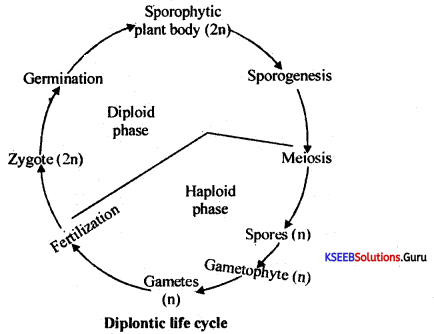
- The dominant phase in the life cycle is the independent sporophytic plant.
- Meiosis occurs in the spore mother cells during spore formation and the gametophyte is short- and is dependent on the sporophyte.
e.g. Fucus (brown alga), gymnosperms and angiosperms.
![]()
Question 28.
Write the General characters of the phylum Echinodermata?
Answer:
Echinodermata comprises animals with a spiny skin. About 6000 species of echinoderms have been described.
General characters:
1. They are exclusively marine.
2. Echinoderms are rounded, cylindrical, or star-shaped organisms.
3. The body is triploblastic, coelomate, and unsegmented with radial symmetry. (But larvae are bilaterally symmetrical).
4. Body is generally covered by skin or exoskeleton supported by an endoskeleton made up of calcareous plates/ossicles. From these plates, spines may arise which project through the epidermis (skin).
5. Head is absent, and the body is distinguishable into oral, and aboral surfaces.
6. Coelom is extensive, enterococcus filled with coelomic fluid, and amoebocytes.
7. They possess a characteristic Ambulacra) or water vascular system. It consists of a system of tubes that emerge as a series of pouch-like projections from the body surface as body appendages 1 podia/tube feet, and help in locomotion, food capture, and respiration.
8. Alimentary canal (Digestive system) is complete with a mouth on the oral surface and anus on an aboral surface.
9. Circulatory system is primitive and reduced. It s haemal, macular, or coelomic channels. (Thu it is an open type of circulatory system).
10. Respiration may body minute gills called dermal branchiae or papillae (star-fishes) or by tube feet, or by. genital bursae (brittle star) or peristomial gills (sea urchin) or by cloacal respiratorý trees (cucumaria).
11. Excretory system is absent. The excretory product is ammonia, which is eliminated by amoebocytes of the coelomic fluid.
12. Nervous system is primitive, and consists of 3 nerve rings, and radial nerves.
13. Sensory system ¡s poorly developed. It comprises simple eyes and chemoreceptors.
14. Sexes are separate with large gonads, and simple ducts.
15. Fertilisation is external.
16. Development is indirect with free-swimming ciliated larval stages.
17. Regeneration of lost parts takes place.
18. They exhibit autotomy i.e., self-amputation of bodý parts to escape from the enemy.
![]()
Question 29.
Describe the major types of simple epithelial tissue, with the help of a labeled diagram?
Answer:
Epithelial tissues are broadly classified into two types namely:
Simple epithelium: Single layered epithelial tissue is known as the simple epithelium.
Stratified epithelium: Multilayered epithelial tissue is known as the stratified epithelium.
Simple epithelium: Simple epithelium is further classified into:
- Squamous epithelium.
- Columnar epithelium.
- Cuboidal epithelium.
- Ciliated epithelium.
- Glandular epithelium.
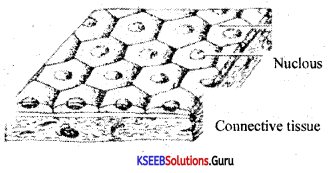
Question 30.
Describe the structure of chloroplast with a neatly labeled diagram?
Answer:
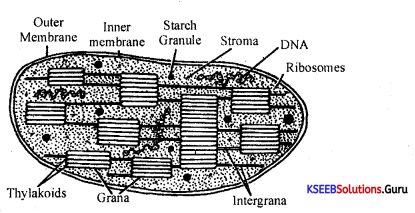
Electron microscopic structure of the chloroplast
Chlorophyll-containing plastids are called Chloroplasts. They are present in the cells of all green plants and abundant in the leaf mesophyll cells. They are elliptical or oval in shape. Chloroplast is bounded by two membranes with the intermembrane space called peri plastidial space, containing peri plastidial fluid. It is made up of H2O, mineral ions, proteins, etc.
It is a lubricating fluid that avoids friction between the two membranes. The inner chamber is filled with a colorless proteinaceous fluid matrix called the stroma. Besides abundant proteins, stroma contains 70s ribosomes, circular DNA, and all the enzymes of the Calvin cycle.
Embedded in the stroma, there are green-colored bodies called grana, which are inter-connected by frets. Grana is the site of light reaction, each granum consists of a stack of lipoprotein membrane discs called Thylakoids. Each thylakoid contains several photosynthetic centers called quanta somes. Each quantasome contains about 250 chlorophyll pigments and a few xanthophylls and carotenes.
Only chlorophyll- is capable of harvesting light energy into photosynthesis and hence it is called the primary photosynthetic pigment. All the other pigments, merely absorb lightener’ and pass it on to chlorophyll, and hence are called accessory photosynthetic pigments.
Note: As chloroplasts contain circular DNA 70s ribosomes and as they go for protein synthesis, they are regarded as semi-autonomous cell organelles.
Question 31.
Draw a neatly labeled diagram of the nephron.
Answer:
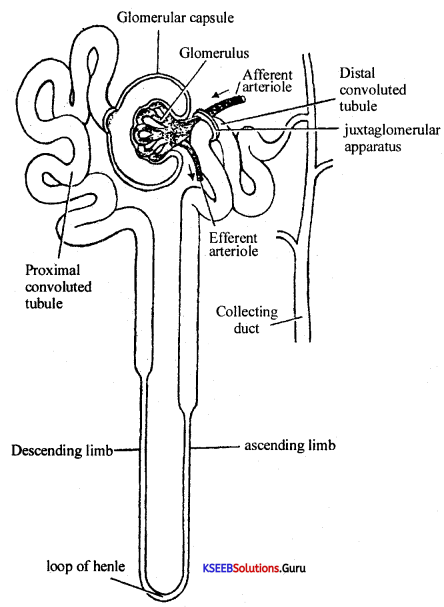
![]()
Question 32.
Discuss the role of pancreatic hormones in the regulation of blood glucose levels.
Answer:
The pancreas is both an exocrine and an endocrine gland. For its endocrine function, it has islets of Langerhans. These islets have β (beta) or β cells, α (alpha) or A cells, and (delta) or D cells. The β cells secrete insulin and A cells secrete glucagon. Both are proteinaceous hormones regulating blood glucose levels.
The D cells secrete a hormone called somatostatin. It inhibits the digestion and absorption of nutrients. It also inhibits the secretion of insulin and glucagon.
1. Glucagon:
- It is a peptide hormone.
- It is a hyperglycemic hormone, i.e., it increases the level of glucose.
- It acts on the liver cells and hepatocytes ¡n the blood.
- It stimulates glycogenolysis and increases the level of glucose in the blood.
- It stimulates gluconeogenesis and the synthesis of glucose from amino acids.
2. Insulin:
- It is a peptide hormone.
- It is a hypoglycemic hormone, Le., it reduces the level of glucose in the blood by stimulating the uptake and utilization of glucose by tissue cells.
- It acts on the hepatocytes and stimulates the conversion of glucose into fats.
- It also acts on adipocytes and stimulates the conversion of glucose into fats.
- Deficiency of insulin causes hyperglycemia and prolonged hyperglycemia results in diabetes mellitus
Section II
Answer any THREE of the following questions in 200-250 words each. (3 × 5 = 15)
Question 33.
With a neat labeled diagram, explain phloem tissue.
Answer:
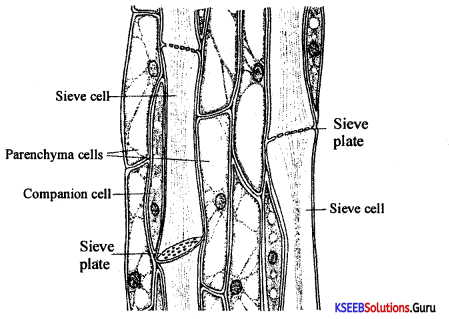
Phloem is a food conducting tissue and is also called bast. Phloem is composed of four elements:
(a) Sieve elements
(b) Companion cells
(c) Phloem parenchyma
(d) Phloem fibers.
(a) Sieve elements: Sieve elements in lower vascular plants (Pteridophytes and gymnosperms) are referred to as ‘sieve cells’ whereas in higher plants (Angiosperms) they are referred to as ‘sieve tubes’.
Sieve cells are elongated, thin-walled, and arranged one above the other, and show a thin protoplasmic layer within. Sieve cells possess perforated lateral walls and they are not associated with companion cells, but with the cells called albuminous cells.
Sieve tubes are much longer than sieve cells and are arranged one above the other longitudinally with perforated transverse end walls, called ‘sieve plates’. Protoplasmic strands maintain the continuity through these perforations with the adjoining sieve tubes, sieve tubes are living cells but they are enucleated.
At the end of the growing season, sieve pores are covered by deposits of callose.
(b) Companion cells: These are thin-walled living and narrow cells running parallel to sieve tubes in angiosperms. Sieve tubes and companion cells are sister cells derived from the same mother cell. These are known to regulate the functions of sieve tubes.
(c) Phloem parenchyma: Parenchyma cells associated with phloem are referred to as phloem parenchyma. They are stored in function. Phloem parenchyma is absent in the monocot stem.
(d) Phloem fibers: These are sclerenchyma fibers associated with phloem. They are also called bast fibers. They provide mechanical support to the plant body.
![]()
Question 34.
Draw a neatly labeled diagram of the sagittal section of the brain.
Answer:
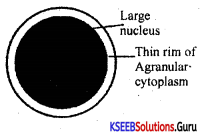
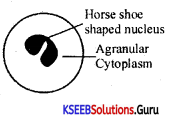
Question 35.
List the physiological effects of Auxins on plants.
Answer:
- Auxins were the first hormones to be discovered in plants.
- F.W. Went confirmed and isolated the auxins from coleoptiles of Avena saliva.
- Chemically it is called Indole-3-Acetic Acid and is derived from amino acid tryptophan.
- Auxins can stimulate cell division, cell elongation, and cell maturation.
- It promotes Apical dominance.
- It initiates Root formation.
- Can promote parthenocarpy.
- Prevent premature fall of flowers, buds, and leaves.
- 2, 4D, and 2, 4, 5T are used as selective weedicides.
- Promote phototrophic and hydrotropic movements.
- Promote xylem differentiation.
Question 36.
Describe the various stages of prophase I of meiosis I.
Answer:
During this process the diploid parent cell divides into two daughter cells which are haploid, hence it ¡s a reduction division.
A. Karyokinesis I:
1. Prophase I: It lasts for quite a long period and is studied under five substages.
- Leptotene
- Zygotene
- Pachytene
- Diplotene
- Diakinesis.
1. Leptotene: (Gr leptons slender; tene – thread),
- The chromosomes are thin, long, and uncoiled. Each is a double chromosome consisting of two chromatids. These chromatids are held firmly.
- Each chromosome appears as a string of beads, the beads are the chromomeres.
2. Zygotene: (Gr: Zygon-male; tene- thread)
During this stage, the pairing of homologous chromosomes (half of the maternal and half of them paternal). This pairing is called synapsis. The pairs so formed are called bivalents.
Each bivalent consists of four chromatids and is therefore called a tetrad. The two chromatids of the same chromosomes are called sister chromatids and the belonging to two different chromosomes of a homologous pair are termed non-sister chromatids.
3. Pachytene: (Gr: Pachus – thick tene – thread).
Crossing over takes place by breakage and reunion of chromatid segments. After, crossing over, the two chromatids of a chromosome become dissimilar.
The points of interchange are X-shaped and are called chiasmata. (smg.chiasma)
4. Diplotene: (Gr: Diplo – double; one – thread)
- Repulsion between homologous chromosomes begins.
- Each tetrad now appears in different shapes j.c, X-shaped, ‘8’ shaped, or ‘O’ shaped.
- Repulsion results in the criminalization of chiasmata (sliding of chiasmata towards the ends of chromosomes.
5. Diakinesis: (Gr: dia-cross; kinesis- movement).
- The nucleolus breaks down and disappears.
- Spindle fibers appear.
- The nuclear membrane breaks down.
- Chromosomes are released into the cytoplasm.
1. Metaphase I: It is characterized by the completion of spindle formation. In animals cells, asters are formed around the centrioles at two poles. The paired chromosomes arrange themselves on the equator of the spindle fibers.
2. Anaphase I: Ñere, the spindle fibers contract and this makes the bivalents move towards the opposite poles of the spindle without the division of centromere. The separated chromosomes or univalents are also called dyads because each of them consists of two chromatics that remains attached to each other at the centromere.
3. Telophase I: Chromosomes undergo uncoiling. A nuclear envelope is formed around each group of chromosomes. The nuclei do not reappear now.
![]()
Question 37.
Draw a neat labeled diagram of the digestive system of cockroaches.
Answer:
